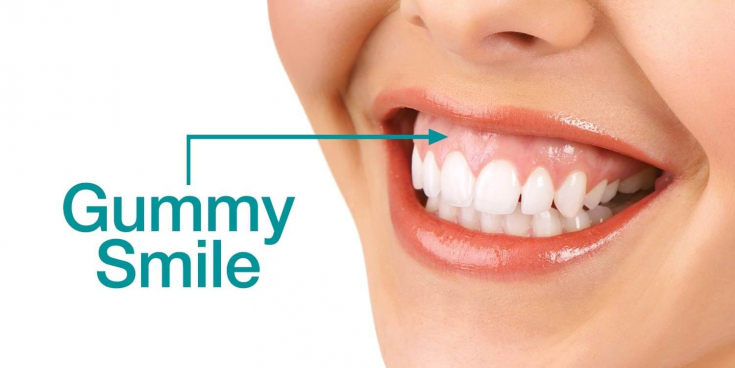Many people dream of a beautiful smile. Aesthetically, the right smile depends not only on the condition of the teeth and the shape of the lips, but also onhow much the gums are exposed when smiling.
The proportions of a smile play an important role in the social realization of a person.
The most beautiful and aesthetically pleasing smile is when exposed no more than 3 mm of gum.
If more gums are visible, then such a smile is called gingival (gingival). Gummy smile is twice as common in females.
Up to 15% of the world's population has a gingival smile.
With age, the gum tissue in the process of smiling is more covered due to the loss of skin elasticity, a decrease in the tone of the orbicular muscle of the mouth, as well as the action of gravity.
Therefore, it is believed that the gingival smile is more characteristic of young people.
Read more on estet-portal.com main causes and mechanism of gingival smile development.
- The main causes of the development of a gingival smile
- What are the mechanisms of gingival smile formation
- What are the types of gum smileand
The main causes of the development of a gingival smile
In terms of the anatomy and physiology of the face, the smile depends on the degree of contraction of the lower and middle third of the face, as a result of which the teeth and gums are exposed.
Thus, the appearance of a smile depends on three components and their relationship to each other - lips, teeth and gums.
If these proportions are violated, a gingival smile is formed.
Proportions are broken due to some reasons:
- Anomalies of dentoalveolar structures.
Due to genetic or external factors, the upper jaw may grow excessively vertically.
This results in an overexposure of the gingiva that covers the anterior alveolar process.
Misalignment of the upper and lower incisors, as well as rotation of the upper jaw, can also cause a gingival smile.
- Soft Tissue Features.
The base of the upper lip may be attached too high, or its vertical dimension may be reduced.
This causes the gum tissue to show.
This can also be observed when the hyperactive mimic muscles of the face strongly shift the lip upwards, despite the normal proportions and parameters of the face and teeth.
- Dento-alveolar extrusion, i.e. "lengthening" anterior maxillary teeth due to excessive eruption.
With this variant of the gingival smile, the gingival tissue moves down along with the underlying bone.
Then the gum becomes more visible when smiling against the low position of the upper anterior teeth.
- "Excess" gums.
Occurs due to a pathological increase in the size and volume of the gingival tissue and a delay in the process of its natural migration to the apex.
It can also be due to the low crowns of the anterior teeth. Then the gum covers most of the crown of the tooth and a gingival smile is formed.
The above causes can begin to develop even in utero if there are damaging factors for the skeletal system of the childka.
Gum recession: causes and serious consequences of tooth exposure
What are the mechanisms of gingival smile formation
The formation of the defect occurs due to the development of disproportions that may occur during the growth of the child maxillary complex.
The proportionality of the development of ENT organs depends on many factors, including the frequency of ENT pathologies, nutrition, the presence of injuries and the quality of nasal breathing. So, polyps can cause the formation of an adenoid type of face.
When the vertical type of growth prevails over the horizontal, the lower third of the face increases and the face becomes elongated. At the same time, gingival tissue is seen in excess when smiling, and such a smile is considered gingival.

If there is no reason for the growth of the skeleton, the cause of a gingival smile can be excessive protrusion of the anterior teeth during eruption.
Against the background of hypertrophy and hyperplasia of cells and during the production of intercellular substance, the teeth pull out the gum tissue and the bone underneath.
There may be hyperplastic processes in the gum tissue, which will result in the formation of a gum sacbku.
Read our articles on Facebook!
What are the varieties of gum smile
Depending on the muscles involved and the degree of gum exposure in plastic surgery and
- Lateral –
- When smiling, the gingival tissue is visualized more than it should be only in the lateral sections. At the same time, the small and large zygomatic muscles are involved in the process. Frontal –
- develops due to hyperfunction of the muscles that lift the upper lip and the muscles that lift the wing of the nose and lips. The gums are exposed 2-3 mm between the canines. Asymmetric
- – the gum is more visible on one side. It is observed with increased contraction of the large and small zygomatic muscles and / or the muscle that raises the upper lip.
Mixed – against the background of increased muscle activity, lifting the lips and zygomatic muscles, the gum tissue unnecessarily opens throughout the alveolar process, as well as between and behind the canines. - Some experts believe that the formation of a gingival smile develops only due to improper functioning of the muscles that lift the upper lip and nose wings. Other experts believe that only such muscles are involved in the process - the circular and lowering nasal septum. And the third authors are sure that all of the above muscles are involved in the process of a gingival smile.
Cosmetic dentistry will restore the smile to its former youth







Add a comment